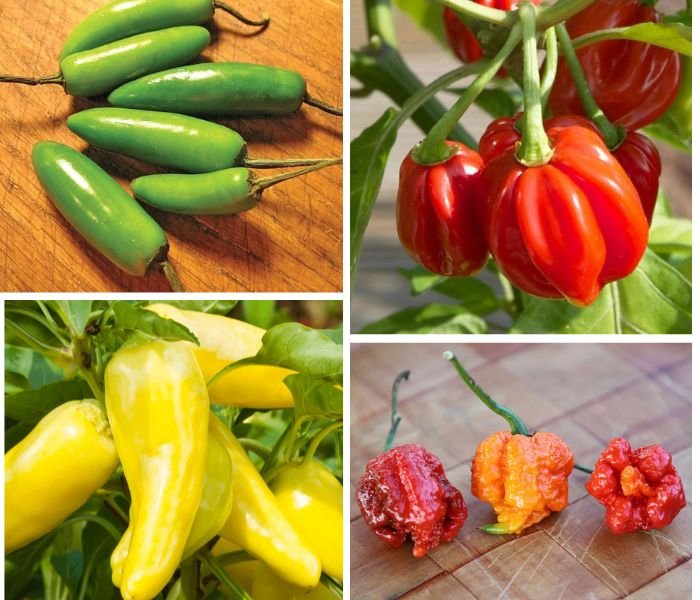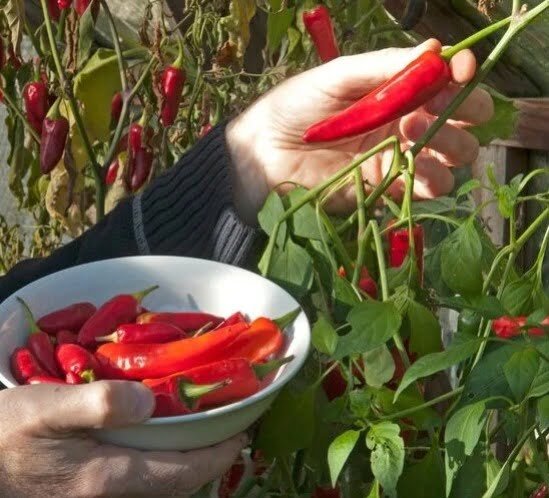Unleash the flavor in your cooking by growing your own chili peppers! This comprehensive guide covers everything you need to know from choosing the perfect varieties to planting, nurturing and harvesting a bountiful crop of fiery and delicious chilies.
The Ultimate Guide to Growing Chili Plants

Chili peppers are a versatile and flavorful addition to any garden, bringing a burst of heat and vibrant colors to your outdoor space. Whether you’re a seasoned gardener or a newcomer to the world of homegrown produce, cultivating your own chili plants can be a rewarding and enjoyable experience. In this ultimate guide, we’ll walk you through the essential steps to ensure a thriving and bountiful chili pepper harvest.
Here’s a detailed information chart for Chilli Plants:
| Aspect | Details |
|---|---|
| Botanical Name | Capsicum annuum (common species), Capsicum chinense (for hotter varieties) |
| Common Names | Chili Pepper, Chilli, Hot Pepper |
| Plant Type | Annual (in temperate climates), Perennial (in tropical climates) |
| Zones | USDA Zones 9-11 (perennial), grown as an annual in cooler zones |
| Exposure | Full sun |
| Bloom Time | Summer |
| Height/Spread | 1-4 feet tall, 1-3 feet wide |
Choosing the Right Chili Varieties

With hundreds of chili pepper varieties available, selecting the perfect ones for your garden can be a daunting task. Consider these factors when making your choice:
- Heat Level: Chili peppers range from mild and sweet to scorchingly hot. Common heat levels include:
- Mild: Banana peppers, Anaheim peppers
- Medium: Jalapeño, Serrano
- Hot: Habanero, Scotch Bonnet
- Extremely Hot: Ghost pepper, Carolina Reaper
- Size and Shape: Chilies come in various shapes, from long and slender to round and plump. Consider the intended use (e.g., stuffing, drying, or sauces) when selecting the size and shape.
- Color: Chili peppers can be found in a rainbow of colors, including red, yellow, orange, purple and even chocolate-brown. Choose varieties that appeal to your aesthetic preferences.
- Growing Season: Some chili varieties mature faster than others, so consider your local climate and growing season when making your selection.
Setting Up the Ideal Growing Environment

Chili peppers thrive in warm, sunny conditions with well-draining soil. Here’s how to create the perfect environment for your plants:
- Sunlight: Chili peppers require at least 6-8 hours of direct sunlight per day. Choose a location that receives ample sunlight throughout the day.
- Soil: Chilies prefer well-draining, nutrient-rich soil with a slightly acidic pH between 6.0 and 6.8. Amend your soil with compost or aged manure to improve fertility and drainage.
- Temperature: Chilies love warm temperatures, ideally between 70°F and 90°F (21°C and 32°C). In cooler climates, consider starting your plants indoors or using a greenhouse or cold frame.
- Spacing: Proper spacing is essential for air circulation and preventing disease. Space plants 12-24 inches (30-60 cm) apart, depending on the variety’s mature size.
Planting and Caring for Your Chili Plants

Once you’ve prepared the ideal growing environment, it’s time to get your chili plants in the ground. Follow these steps for successful planting and care:
- Starting from Seed: Sow chili seeds indoors 6-8 weeks before the last expected frost. Use a seed-starting mix and provide bottom heat for optimal germination.
- Transplanting: When the seedlings have developed their first set of true leaves and the weather is warm enough, transplant them into your prepared garden bed or containers.
- Watering: Chili plants require consistent moisture, but be careful not to overwater. Water deeply at the base of the plant, aiming for about 1-2 inches (2.5-5 cm) of water per week.
- Fertilizing: Feed your chili plants with a balanced, water-soluble fertilizer every 2-4 weeks during the growing season. Avoid over-fertilizing, as excess nitrogen can promote leafy growth at the expense of fruit production.
- Pruning and Staking: Prune off any suckers (shoots growing from the base) to encourage bushier growth and better air circulation. Stake or cage larger plants to provide support as they grow and produce fruit.
- Pest and Disease Management: Keep an eye out for common pests like aphids, whiteflies and spider mites, as well as diseases like bacterial leaf spot and powdery mildew. Practice good garden hygiene and use organic pest control methods when necessary.
Harvesting and Preserving Your Chili Bounty

As your chili plants mature, you’ll be rewarded with a bountiful harvest of flavorful and fiery peppers. Here’s how to properly harvest and preserve your crop:
- Harvesting: Chilies are ready for harvest when they reach their desired size, color and firmness. Use pruning shears or scissors to snip the peppers from the plant, leaving a small stem attached.
- Drying: Drying is an excellent way to preserve chilies for long-term storage. String the peppers together or lay them on a mesh screen in a warm, dry location with good air circulation.
- Freezing: For fresh chili flavor year-round, wash and slice the peppers, then spread them on a baking sheet to freeze. Once frozen, transfer them to an airtight container or freezer bag.
- Pickling: Pickled chilies make a tangy and spicy addition to various dishes. Follow a trusted pickling recipe and properly seal the jars for safe storage.
- Chili Powder and Flakes: Dry your chilies thoroughly, then grind or crush them into powder or flakes for convenient seasoning and cooking.
Growing your own chili peppers is a rewarding journey that not only provides you with fresh, flavorful ingredients but also adds vibrant colors and spicy flair to your garden. By following this ultimate guide, you’ll be well-equipped to choose the perfect chili varieties, create an ideal growing environment and nurture your plants from seed to harvest. Embrace the challenge of cultivating chilies, and savor the delicious and fiery rewards of your homegrown bounty.